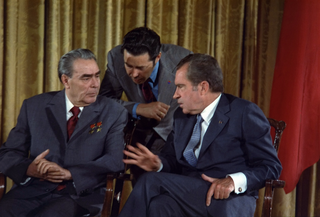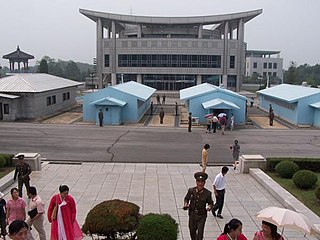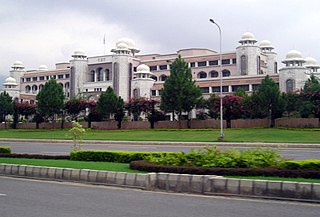Telecommunications in North Korea refers to the communication services available in North Korea. North Korea has not fully adopted mainstream Internet technology due to some restrictions on foreign interventions.
The People's Republic of China possesses a diversified communications system that links all parts of the country by Internet, telephone, telegraph, radio, and television. The country is served by an extensive system of automatic telephone exchanges connected by modern networks of fiber-optic cable, coaxial cable, microwave radio relay, and a domestic satellite system; cellular telephone service is widely available, expanding rapidly, and includes roaming service to foreign countries. Fiber to the x infrastructure has been expanded rapidly in recent years.

The Nuclear Suppliers Group (NSG) is a multilateral export control regime and a group of nuclear supplier countries that seek to prevent nuclear proliferation by controlling the export of materials, equipment and technology that can be used to manufacture nuclear weapons.

Détente is the relaxation of strained relations, especially political ones, through verbal communication. The diplomacy term originates from around 1912, when France and Germany tried unsuccessfully to reduce tensions.
Ten-digit dialing is a telephone dialing procedure in the countries and territories that are members of the North American Numbering Plan (NANP). It is the practice of including the area code of a telephone number when dialing to initiate a telephone call. When necessary, the ten-digit number may be prefixed with the trunk code 1, which is referred to as 1+10-digit dialing or national format.

Mobile radio telephone systems were mobile telephony systems that preceded modern cellular network technology. Since they were the predecessors of the first generation of cellular telephones, these systems are sometimes retroactively referred to as pre-cellular systems. Technologies used in pre-cellular systems included the Push to Talk, Mobile Telephone Service (MTS), Improved Mobile Telephone Service (IMTS), and Advanced Mobile Telephone System (AMTS) systems. These early mobile telephone systems can be distinguished from earlier closed radiotelephone systems in that they were available as a commercial service that was part of the public switched telephone network, with their own telephone numbers, rather than part of a closed network such as a police radio or taxi dispatching system.
119 (one-one-nine) is an emergency telephone number in parts of Asia and in Jamaica. From May 2020, 119 was introduced in the United Kingdom as the single non-emergency number for the COVID-19 testing helpline in England, Wales, and Northern Ireland. From January 2022, 119 was introduced in Romania as the single non-emergency number for reporting cases of abuse, neglect, exploitation and any other form of violence against the child.

The Moscow–Washington hotline is a system that allows direct communication between the leaders of the United States and the Russian Federation. This hotline was established in 1963 and links the Pentagon with the Kremlin. Although in popular culture it is known as the "red telephone", the hotline was never a telephone line, and no red phones were used. The first implementation used Teletype equipment, and shifted to fax machines in 1986. Since 2008, the Moscow–Washington hotline has been a secure computer link over which messages are exchanged by a secure form of email.

Area code 856 is a telephone area code in the North American Numbering Plan (NANP) for the southwestern part of the U.S. state of New Jersey. The numbering plan area (NPA) includes the Camden, Cherry Hill, and Vineland areas and a small part of Willingboro Township and the western part of Burlington County. 856 is essentially coextensive with the New Jersey side of the Philadelphia metropolitan area.
Telephone numbers in South Korea are organized and assigned using the following scheme
A hotline is a point-to-point communications link in which a call is automatically directed to the preselected destination.

Relations between India and the United States date back to India's independence movement and have continued well after independence from the United Kingdom in 1947. Currently, India and the United States enjoy close relations and have deepened collaboration on issues such as counterterrorism and countering Chinese influence in the Indo-Pacific.
A bat phone or batphone, in popular jargon, is a private telephone number for important telephone calls handled at high priority. The term is also used to describe the use of more than one mobile phone, with the "bat phone" reserved for a specific purpose. The name Bat-Phone was popularized by the Batman television series starting in 1966, when it was depicted as a red phone that Commissioner Gordon used to summon the superhero Batman in emergencies, and as the red phone mounted inside the Batmobile, the car driven by Batman. Technology journalists have also used "Bat Phone" to describe devices that are novel in appearance, or have a connection to the Batman franchise.
Telephone numbers in North Korea are regulated by the Ministry of Post and Telecommunications.

A missed call is a telephone call that is deliberately terminated by the caller before being answered by its intended recipient, in order to communicate a pre-agreed message. It is a form of one-bit messaging.

The Seoul–Pyongyang hotline, also known as Inter–Korean hotline, is a series of over 40 telephone lines that connect North and South Korea. Most of them run through the Panmunjom Joint Security Area (JSA) within the Korean Demilitarized Zone (DMZ) and are maintained by the Red Cross.

The Islamabad–New Delhi hotline is a system that allows direct communication between the leaders of India and Pakistan. The hotline, according to the media sources, was established in 1971, shortly after the end of the 1971 war. The hotline linked the Prime minister's Office in Islamabad via Directorate-General of Military Operations (DGMO) to Secretariat Building in New Delhi.
The foreign policy of the Modi government is associated with the policy initiatives made towards other states by the current government of India after Narendra Modi assumed the office of prime minister on May 26, 2014.

The most significant initiative made by the Narendra Modi government is the focus on neighbouring countries and major Asian powers coupled with emphasizing on the two decades old Look East policy. Asia being the major focus area of his foreign policy, Modi and his foreign minister chose several Asian countries for their initial bilateral visits. He has made state visits to Bhutan and Nepal and Japan within the first 100 days of his government and also hosted Asian leaders like former Prime Minister Tony Abbott of Australia, President Xi Jinping of China and Prime Minister Nguyễn Tấn Dũng of Vietnam, apart from inviting SAARC leaders in his inauguration ceremony. External Affairs Minister Sushma Swaraj has also made official visits to several Asian capitals like Dhaka, Bangladesh, Kathmandu, Nepal, Naypidaw, Myanmar, Singapore, Hanoi, Vietnam, Manama, Bahrain, Kabul, Afghanistan, Dushanbe, Tajikistan, Malé, Maldives, Abu Dhabi, United Arab Emirates, Seoul, South Korea and Beijing China.

The Beijing–Washington hotline is a system that allows direct communication between the leaders of the United States and China. This hotline was established in November 2007, when both countries announced that they would set up a military hotline to avoid misunderstanding between their militaries during any moments of crisis in the Pacific.











